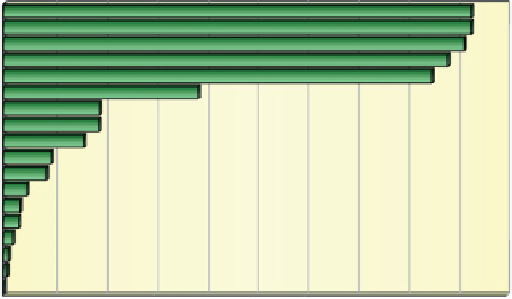Environmental Engineering Reference
In-Depth Information
effi cient than this. In Germany and Great Britain a photovoltaic system with 15%
effi ciency can generate around 495 000 kilowatt hours of electric power per year on
one hectare of land or 200 000 kilowatt hours per acre. This corresponds to a con-
verted diesel equivalent of more than 50 000 litres per hectare.
12.8 Biomass Markets
Biomass use varies widely in different parts of the world. Biomass is by far the
most important energy source in the poorest countries of the world and in some
countries even constitutes more than 90% of primary energy needs (Figure 12.21).
The reasons for this are mainly economic. Most people in these countries simply
cannot afford crude oil, natural gas or electricity from coal-fi red power plants. In
most industrialized countries like Britain, Germany and the USA the biomass share
is well below 10%. The only exceptions are countries like Finland and Sweden,
which are densely wooded and sparsely populated.
93
Ethiopia
93
Congo
92
Tanzania
88
Mozambique
85
Nepal
39
India
19
Finland
19
China
16
Sweden
9
Austria
8
Denmark
5
France
3
Spain
USA
3
Germany
2
Great Britain
1
Russia
0.6
Saudi Arabia
0
0 0 0 0 0 0 0 0 0 0 0
biomass share of the primary energy demand in %
Figure 12.21
Biomass share of primary energy demand in different countries.
Status: 2001, Data: (International Energy Agency, 2003).
Biomass is used very differently by industrialized and developing countries. In many
developing and emerging countries biomass is still used in the traditional way.
These countries see the main use of biomass as fi rewood for cooking. Industrialized
countries, on the other hand, focus on the modern forms of biomass use. These
include comfortable biomass heating systems, biomass power plants and biomass
fuels. The proportion of modern biomass is also increasing in industrialized coun-
tries. For example, Sweden has set itself the goal of becoming independent of crude
oil by 2020 mainly through an increase in biomass use. The potential is lower in
more densely populated countries like Germany and Britain. But even in these
countries a 10% biomass share in primary energy requirements is conceivable in
the long term.




